Solar Power
In
BC's Central Interior
You
can sell your excess solar energy to BC Hydro. Here
is the information.
Solar power systems used to be small and
expensive and provided a bare minimum of essential electricity to remote
off-grid homes and cabins. That is no longer the case. Technical
advancements and mass production have resulted in a dramatic drop in solar
module prices. To compare the price between different sized solar modules,
divide the price by the number of watts that the module is rated for. This
gives you a dollar per watt figure. Solar energy dealers are selling the
large solar modules for about 1/3 the price per watt that the big box
stores are charging for their smaller modules.
The electronic components used in solar
energy systems are now all computerized high tech marvels. Modern charge
controllers use Maximum Power Point Tracking (MPPT) technology to squeeze
ever last watt out of a solar array or wind turbine. (The old technology,
less efficient charge controllers are still available).
Inverters are much larger than they used to be
and now generate 120/240 volt split phase power just like the grid does.
Your surplus power can even be sold back to the grid (BC Hydro). (Here
is a story about one installation) If your needs grow, additional
inverters can be added to the system and they are even available in
3-phase configurations. Old technology inverters are still available in
the big box stores but they are intended for portable, temporary use and
are not to be installed
in homes or cabins.
Solar power systems are available in three
basic types, off grid, grid tie without battery back up, and grid tie with
battery back up. Solar PV systems are not just for off grid living any
more. With the price of grid power rising and solar prices dropping, many
people are opting to add solar power systems to their on-grid homes. The
cost of BC Hydro's electricity and solar generated electricity are now
about the same over the life of a system. However, with rising grid
prices, solar will soon be less expensive than the grid. With solar, you
have to pay up-front for 20+ years of energy. The low mortgage rates make
it attractive to finance a solar power system as part of a home purchase
or renovation.
Terminology
The word "panel" has been over used to the point of confusion. To reduce
the confusion, solar photovoltaic (PV) units are now called modules
and solar thermal units are called collectors.
Several modules mounted on a frame as shown in these photos are called an
array.
Power is a rate
of energy consumption and is measured in watts or kilowatts (1,000 watts).
Energy is the power consumed multiplied
by the number of hours that you were using it and is measured in
kilowatt-hours (kWh). The utility meters on buildings measure energy
consumption in kWh. There is no such thing as kilowatts per hour. The word
"per" indicates division, not multiplication.
Solar Trivia
The earth rotates 360 degrees in 24 hours which is 15° per hour or 1/4°
per minute. The apparent elevation angle of the sun in the sky changes ±23
½° (from solstice) over the course of a year at a maximum rate of .016°
per hour (.384°/day). Here at 53° north latitude, the sun's apparent path
on the shortest day of the year (winter solstice) is 98° of arc, little
more than a quarter of a revolution and rising only 12.7° above the
horizon at solar noon. However, on the longest day of the year (summer
solstice) the sun rises at 04:40 and sets 17 hours later at 21:42 and the
sun's apparent arc is 268° or about 3/4 of a complete revolution and it
reaches 60° above the horizon. A total eclipse can theoretically last up
to 7.5 minutes.
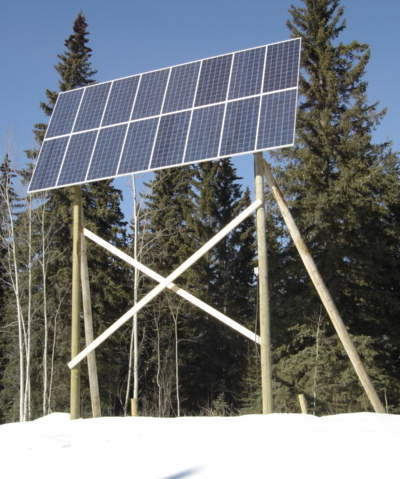
|
This is one of several arrays that we installed in 2013. They
ranged from from 4 to 16 modules each.
We installed this array of sixteen, 290 watt modules at an off-grid
site. Each solar module is about 1m wide by 2m high.
This 4,600 watt array charges a 48-volt Surrette battery using a
single Midnite Solar Classic-200 charge controller. The Schneider
Xantrex inverter provides 6 kilowatts of 120/240 volt power.
The pole structure was installed by the home owner. The center of
the array (top of the poles) is 8.5 meters (28 feet) above ground to
prevent shading by the trees during the winter.
The array was assembled on the ground and a crane truck was used to
lift the array into position. A bucket truck was used to do the
attachment and final wiring. |
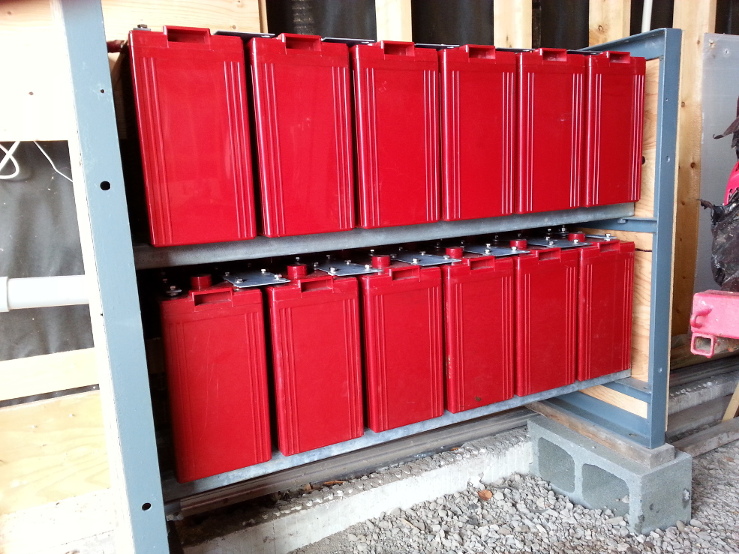
|
To save floor space, this bank of Surrette S2-945 (945-ah) AGM
cells were installed in a steel rack (AKA battery stand).
Each cell has 4 positive and 4 negative posts and all of them must
be connected. We ordered custom plates (straps) to do the inter-cell
connections. The alternative would have been a rats nest of 48
separate cables between the cells! The result is a very neat and
compact installation.
The front and top safety covers on the battery stand completed the
installation.
AGM means Absorbed Glass Mat. They are a starved electrolyte battery
similar in concept to the older gel cells but with different
construction and characteristics. Like gel cells, they are
maintenance free sealed cells with a pressure relief safety valve to
allow gases to escape if the battery is severely over charged. |
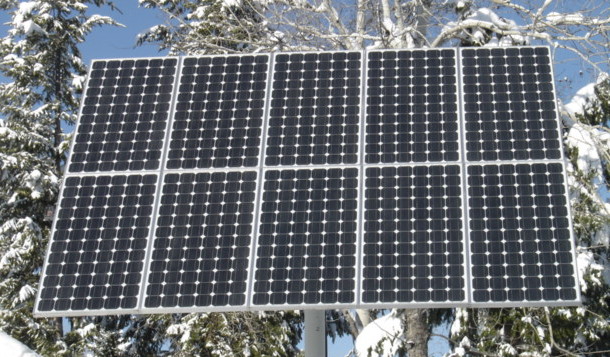 |
This 1.8 Kw array near Prince George is mounted on a dual-axis
tracker so it locks onto the sun's position at sunrise and follows
the sun on its daily trip across the sky. During the summer,
in this area, the sun rises behind a stationary array at about
4:00am and sets behind the array at about 10:00pm. We love our
long summer days! The tracker enables the array to follow the sun
from sunrise to sunset, increasing solar production by up to 8 hours
on the longest days of the year.
Array trackers are not cost effective for off grid installations.
When an array is sized for winter production, in the summer, it will
produce more energy that can be used. With no way to sell the
surplus energy produced by tracking the sun, the money is better
invested in more solar modules.
|
|

|
This array supplies the power for an
off-grid residence that is located a few kilometers north of
Prince George.
In this installation, the mounting
platform is all treated wood construction. It is located on the
side of a south facing hill overlooking the Fraser river. The
solar modules are mounted on aluminum frames that are bolted to
the platform.
|
|
Maintenance free absorbed
glass mat (AGM) batteries are more expensive than flooded cells
(dollars per kilowatt-hour of energy storage) but they are ideal for
remote locations where maintenance is difficult. They are available
in various sizes. The 2-volt cells are preferred for larger battery
banks. This set of S2-590 Rolls batteries (made by Surrette) is
rated at 590 amp-hours at the 100 hour rate |
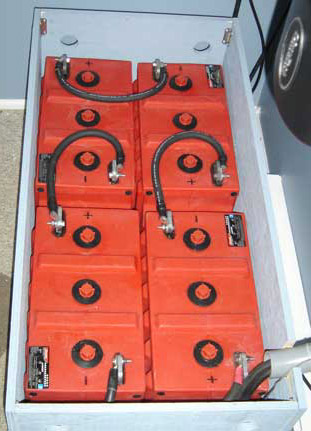
Surrette 927amp-hour
batteries used in a 24-volt
system near Prince George. These double-walled batteries are
suitable for use inside a home. Each of these 6-volt batteries
weighs 316 pounds.
(model
6CS25PS)
Surrette.com
|
 A small backup power system
using solar and wind. This Outback inverter delivers up to 2,800
watts at 120 volts to run the furnace, fridge, freezer, and some
lights. A small backup power system
using solar and wind. This Outback inverter delivers up to 2,800
watts at 120 volts to run the furnace, fridge, freezer, and some
lights.
Too bad the photographer didn't hold the camera level. I'll
try to do better next time. |
For a large battery, a single string is
preferred to connecting smaller batteries in parallel. This set of
twelve Surette/Rolls S-1390 cells forms a 24-volt battery rated at
1,390 amp-hours. 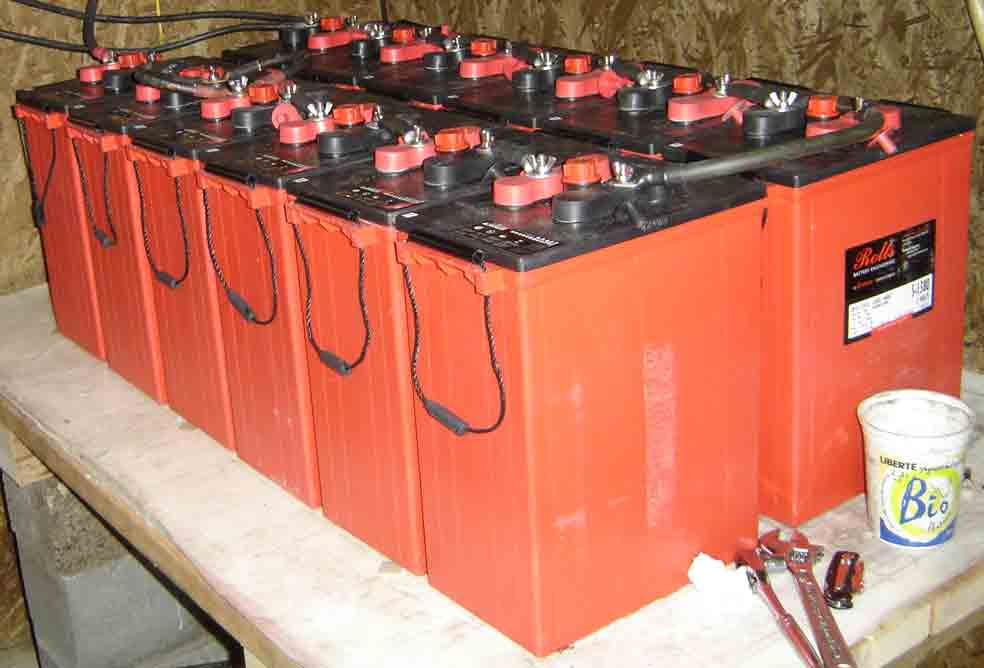 |
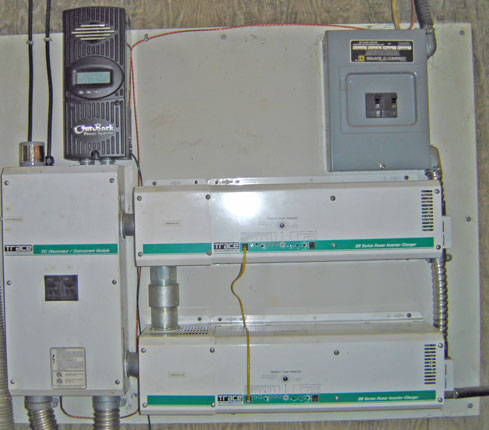
An older system using a pair of Trace 1,500 watt modified square
wave inverters for 120/240 vac power. This equipment is 3
generations old but it's still doing the job.
This system has been upgraded by replacing the original solar
charge controller with an Outback maximum power point tracking
(MPPT) unit. The array was then re-configured to operate at twice
the battery voltage, reducing power loss in the cables to 1/4 its
previous value.
|




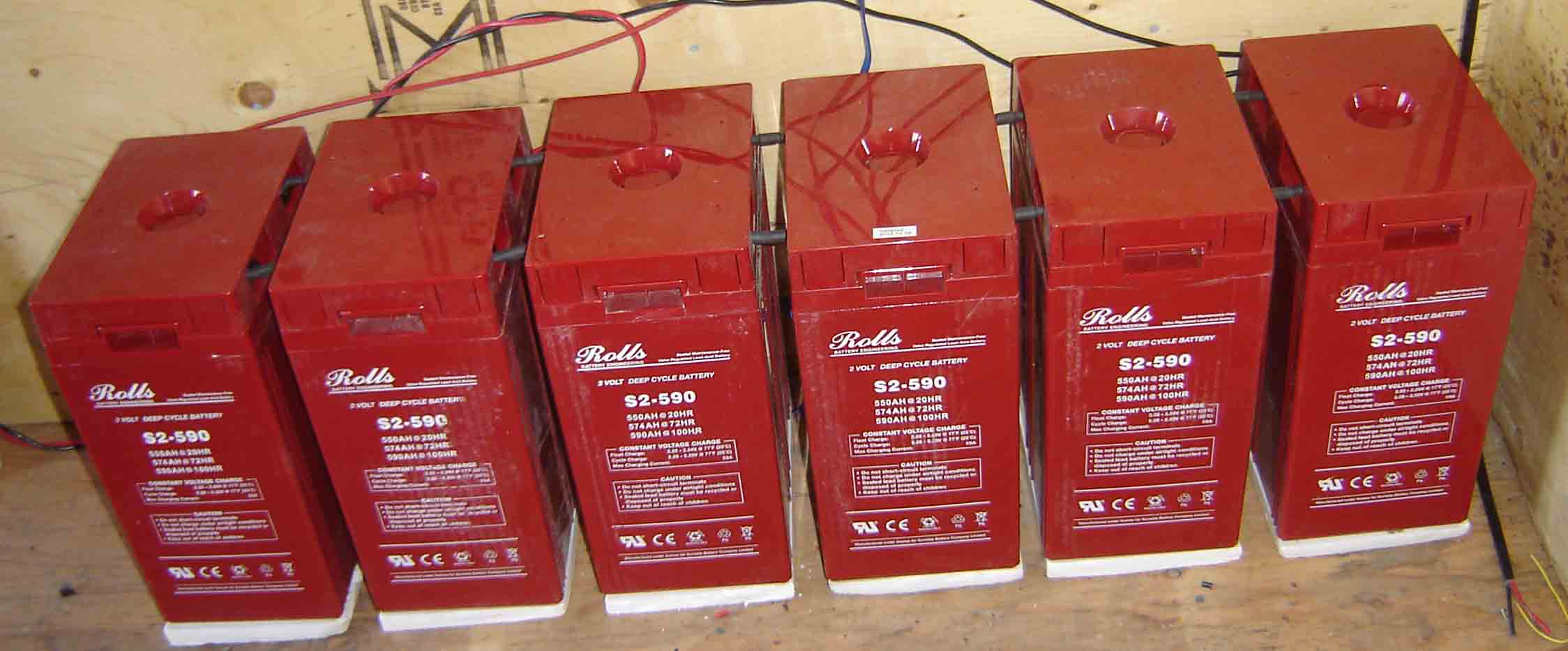

 A small backup power system
using solar and wind. This Outback inverter delivers up to 2,800
watts at 120 volts to run the furnace, fridge, freezer, and some
lights.
A small backup power system
using solar and wind. This Outback inverter delivers up to 2,800
watts at 120 volts to run the furnace, fridge, freezer, and some
lights.
